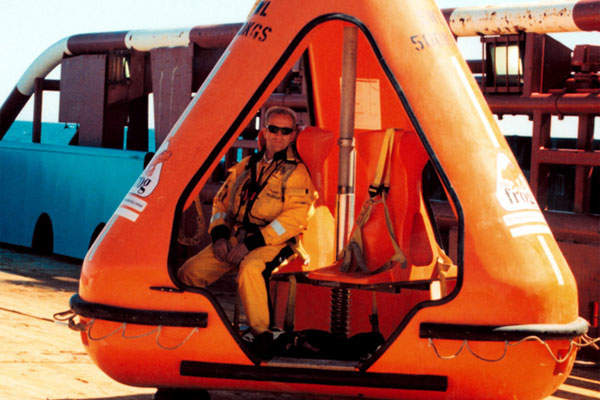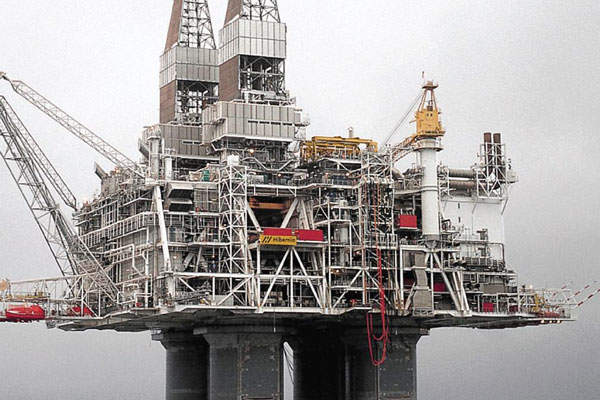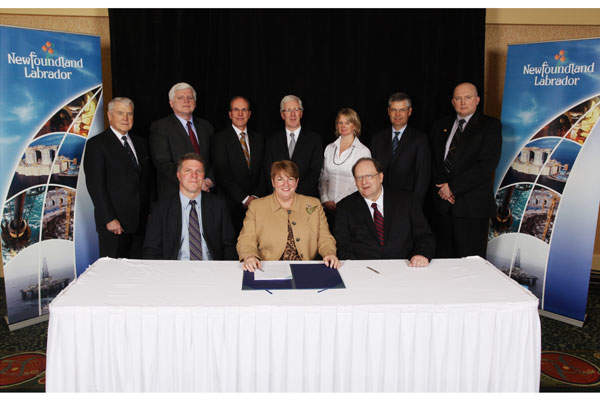
Hibernia field was discovered in 1979 through the drilling of the Hibernia P-15 discovery well by Chevron Canada and its partners. It was the tenth well to be drilled in the Jeanne d’Arc Basin. The well flowed at a rate of 800bpd of 32º API oil and 0.2 million cubic feet per day of gas.
Partners in the field included MOCAN (28.125%), Gulf Canada Resources (25%), Suncor (25%), Chevron (16.40625%) and Columbia Gas (5.46875%).
1980s
The first delineation well, Hibernia O-35, was spud in January 1980. The field’s sole dry hole, Hibernia G-55, was drilled in February 1981 and the first 3D seismic survey of the field was completed in September.
In February 1982, Ocean Ranger mobile offshore drilling unit capsized when it was hit by a strong wave during drilling operations at Hibernia. All 84 crew members lost their lives in what is deemed to be one of the worst offshore oil rig disasters.
Reprocessing of the field’s first 3D seismic survey was completed in December 1985. The original Hibernia Development Plan was approved by the Canada-Newfoundland Offshore Petroleum Board (C-NOPB) and Federal and Provincial Ministers in June 1986.
Columbia Gas sold its share of 5.46875% in the field to Chevron in September 1988. The Hibernia Management and Development Company (HMDC) was formed in December to serve as the operator for the oil and gas field.
1990-6
Canada-Newfoundland Offshore Petroleum Board (CNLOPB) declared the field commercial in January 1990. The 25-year production license for the field was awarded to HDMC in March and an update of the field development plan was submitted within the same month.
The second 3D seismic survey of the field was completed in October 1991. Construction of the iceberg-resistant Hibernia Platform’s gravity base structure (GBS) started in September 1992.
In March 1993, Gulf Canada Resources’ share in the field was acquired and divided among the Government of Canada (8.5%), Murphy Oil (6.5%), Mobil (5%) and Chevron (5%).
Statoil acquired a 5% interest in the field from Suncor’s share in January 1996. The existing shareholders in HMDC are ExxonMobil Canada (33.125%), Chevron Canada Resources (26.875%), Suncor (20%), Canada Hibernia Holding Corporation (8.5%), Murphy Oil (6.5%) and Statoil Canada (5%).
CNLOPB declared that the total reserves of Hibernia were estimated to be 666 million barrels in 1996.
1997-9
Mating of the Hibernia production topsides and GBS was completed in February 1997 and the platform was installed at the project site in June. The field’s first development well, Hibernia B-16 1, was spud in July.
Malikai oilfield is located approximately 100km off the coast of Sabah, Malaysia.
First oil from the field was produced in November 1997. The Hibernia B-16 1 well set a Canadian daily flow rate record at 56,000bpd on 26 December. The first tanker from the field was loaded in December.
Estimated reserves of the field were revised to 750 million barrels in 1997.
Water injection at the field started in May 1998 through the B-16 7 well. The reprocessing of the field’s second 3D seismic survey was completed in August 1998. The Whiffen Head transhipment terminal received the first crude cargo load from the field in October.
Gas injection was introduced on B-16 10 well in January 1999. The platform was temporarily shut down from 11 to 17 March and 20 March to 1 April due to power outage.
Drilling of the field’s longest reach well B-16 11, which measured 8,485m-long, was completed in April. The field produced 5.785 million cubic metres of oil in 1999.
2000
In October 2000, the annual oil production limit from the field was increased from 49.5 million barrels to 66 million barrels. The field produced 8.394 million cubic metres of oil in 2000.
2001
Oil production from the field in 2001 was 8.631 million cubic metres.
2002
HMDC submitted an application to CNLOPB in December 2002 to increase the annual oil production rate of the field from 180,000bpd to 220,000bpd. In 2002, the field produced 65.865 million barrels of oil and 86,776 million standard cubic feet of gas.
2003
Another Canadian record-breaking well, measuring 9,357m-long, was drilled in late 2003. Production from the field in 2003 was 74,127 million barrels of oil and 95,322 million standard cubic feet of gas.
2006
In May 2006, a development plan amendment (DPA) was registered by HMDC with the CNLOPB, to extract oil from the Hibernia Southern Extension (HSE) area. The HSE is estimated to hold 220 million barrels of oil.
Proven and probable oil reserves of Hibernia were revised to 1,244 million barrels in 2006. The field produced 65.098 million barrels of oil and 88,570 million standard cubic feet of gas in 2006, while the average production increased to 178,350bpd.
2007
The Provincial Government initially denied approval for the HSE project in January 2007. The field produced 49.221 million barrels of oil and 73,282 million standard cubic feet of gas in 2007.
HMDC further submitted the technical information to CNLOPB in July, to support the new DPA for the HSE project.
2009
In June 2009, a memorandum of understanding (MOU) was signed between the Provincial Government of Newfoundland and Labrador, represented by Nalcor Energy, and the HSE project partners, including ExxonMobil Canada (27.4%), Chevron Canada Resources (23.6%), Petro-Canada Hibernia Partnership (Suncor, 19.5%), Statoil Canada (10.5%), Nalcor Energy (10%), Canada Hibernia Holding Corporation (5.1%) and Murphy Oil (3.9%).
The development plan for the AA block located within the main Hibernia field in Production Licence PL-1001 was approved in September 2009. Production from the block, which is also tied back to the GBS, started in the same year, increasing the production from the field by 3.1%. The AA block is estimated to contain 48 million barrels of oil.
Cougar Helicopters’ Flight 491, a Sikorsky S-92 helicopter, crashed while on its way to the Hibernia Platform in March 2009, killing 17 occupants and seriously injuring one.
2010
The final agreement for the HSE was signed in February 2010. The $1.75bn project aims to extend the production life of the main field by an additional five to ten years and is estimated to generate around $13bn in revenue for the province.
In April, OPA2 well was drilled to a total depth of 10,122m, which now makes it the longest extended reach well in Canada.
Reserve estimates for the field were revised to 1,395 million barrels in October 2010. The field produced 56.337 million barrels of oil in 2010, an increase by 22.9% from the previous year, while gas production was 90,732 million standard cubic feet. The average monthly production in 2010 was 4.7 million barrels, compared with 3.8 million barrels in 2009.
2011
Major contracts for the HSE project were awarded to FMC Technologies and Technip in early 2011. First oil from the project was produced in June 2011.
2013
Subsea installation for the HSE project was completed in late 2013. On 18 December, an oil spill was reported from the hose end valve (HEV) of the Hibernia Northern Offshore Loading System (OLS).
Annual production was 49.414 million barrels of oil and 97,111 million standard cubic feet of gas.
2014
The oil spill was stopped on 1 January 2014, after the loss of up to 6,000l of oil.
Drilling activities for the HSE began in the first quarter of 2014. Production from the field for the first seven months of 2014 was 26.191 million barrels of oil and 56,687 million standard cubic feet of gas.


















